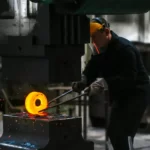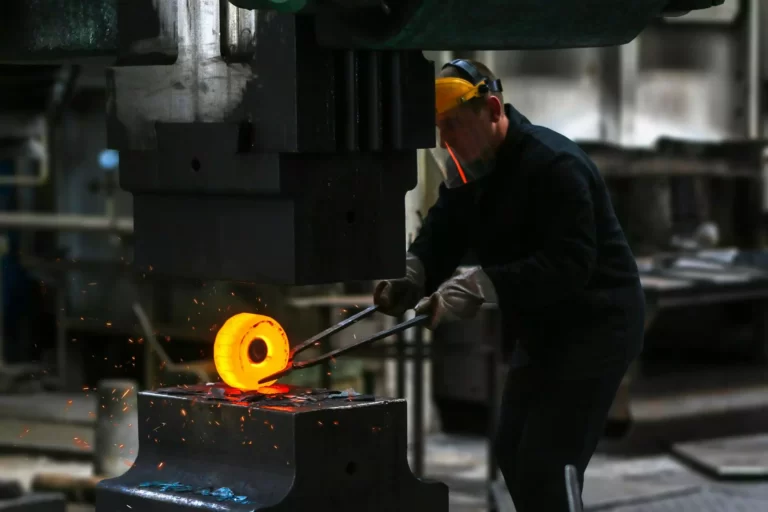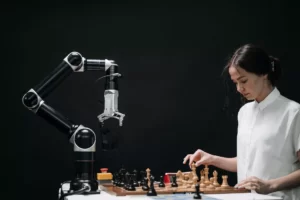The incorporation of artificial intelligence (AI) has caused a revolution in the dynamic field of manufacturing. Businesses may now use AI to create manufacturing solutions that are hyper customized like never before. Welcome to the fascinating world of artificial intelligence powered hyper customized manufacturing, where the possibilities for creativity are endless.
AI is now the engine propelling a new era of production, stretching the frontiers of what was previously considered feasible. It makes it possible for manufacturers to instantly evaluate enormous volumes of data, allowing them to produce goods with previously unheard of precision that are catered to the demands of individual customers.
The era of mass produced goods that are tailored to individual needs is gradually coming to an end, since each product will be as distinctive as the customer who orders it.
The capacity of AI powered hyperpersonalized manufacturing to go beyond simple personalization is what makes it unique. Manufacturers can anticipate client requirements before they are fully aware of them by using AI algorithms to uncover trends and preferences among customers.
By placing the consumer at the center of the production process, this innovative approach to manufacturing guarantees that every product is not just personalized but also in line with the needs and preferences of the buyer.
Imagine a world in which a product’s tiniest details may be customized to your specifications. Every element, from the design and color scheme to the materials chosen, can be thoughtfully chosen to produce a genuinely unique piece. The integration of AI has made this exciting new frontier in manufacturing possible.
Come along on this groundbreaking trip as we explore the fascinating field of AI powered hyper customized manufacturing. One bespoke product at a time, we will investigate the countless opportunities and innovations that are changing the manufacturing landscape together.
In a Nutshell
- Hyperpersonalized manufacturing refers to the use of artificial intelligence (AI) technologies to create highly customized and personalized products.
- It involves automating and optimizing the entire production process, from design to manufacturing, in order to effectively meet specific customer requirements.
- AI technologies, such as machine learning and computer vision, are used to collect data and analyze it in real time, enabling quick and accurate adjustments to the manufacturing process.
- Benefits of hyperpersonalized manufacturing with AI include increased customer satisfaction, reduced waste and costs, improved production speed, and improved product quality.
- By leveraging AI, manufacturers can offer a wider variety of customized products while maintaining efficiency and scalability.
- AI enables the collection and analysis of customer data, which helps manufacturers anticipate and meet customer needs with greater accuracy.
- Hyperpersonalized manufacturing requires the integration of AI technologies into existing production systems as well as the adoption of data driven decision making processes.
- The challenges of hyperpersonalized manufacturing with AI include data privacy concerns, the need for skilled AI professionals, and the potential disruptive effects on traditional manufacturing workforces.
- Despite these challenges, hyperpersonalized manufacturing with AI has immense potential to revolutionize traditional manufacturing processes and create new business opportunities in a variety of industries.
- Companies that successfully implement hyperpersonalized manufacturing with AI will be able to gain a competitive advantage in the marketplace and capture the growing demand for customized products.
Hyperpersonalized manufacturing with AI is revolutionizing the way we produce and deliver products, customizing them to an unprecedented level of precision and efficiency.
Mark Johnson
Understanding Hypercustomization
Artificial intelligence (AI) integration is enabling hyperpersonalization, which is transforming the manufacturing sector. This cutting edge manufacturing technique uses AI algorithms to build highly customized items based on the unique demands and tastes of each consumer, taking personalization to a whole new level. We will examine the idea of hyperpersonalization and how it is influencing manufacturing in the future in this piece.
In a perfect world, every item you possess would be made just for you, according to your preferences and needs. This is now more attainable thanks to hyperpersonalized manufacturing with AI. Conventional production methods frequently rely on mass production, where a single size fits all.
However, hyperpersonalization flips this strategy on its head by giving customers the chance to obtain goods that are actually tailored to their unique requirements.
AI is the main force behind hyperpersonalization. Artificial intelligence (AI) systems are able to evaluate enormous volumes of data regarding consumer preferences, activities, and lifestyles by utilizing machine learning and data analytics. Next, with this data, highly customized product designs are created. Almost everything may be highly personalized to meet specific demands, from furniture and accessories to cars and apparel.
Hypercustomization has advantages beyond producing one of a kind goods. Additionally, this strategy gives businesses additional opportunities. Businesses may boost brand loyalty and improve consumer satisfaction by providing personalized items. Hypercustomization also minimizes waste and production costs by doing away with the requirement for unnecessary inventory.
In summary, AI powered hyperpersonalized manufacturing is revolutionizing the manufacturing sector. It lets businesses cut expenses and waste while producing personalized goods that are catered to individual tastes. Hyperpersonalization will become the new standard as technology develops, changing our perceptions of production and the goods we buy.
How Does Hyperpersonalized Manufacturing with AI Work?
How does AI powered hyperpersonalized manufacturing operate? The idea of using artificial intelligence (AI) to create hypercustomized manufacturing is transforming the way items are manufactured in today’s dynamic manufacturing industry. Through the use of cutting edge manufacturing techniques and artificial intelligence (AI), this novel approach produces highly customized products that are more suited to the specific needs of each individual consumer than in the past.
So how does AI powered hyperpersonalized manufacturing actually operate? Let’s examine this.
First, AI algorithms analyze vast amounts of data gathered from numerous sources, such as consumer preferences, industry trends, and manufacturing capacities. These algorithms find trends and forecast with intelligence what kinds of features people will find desirable in a product.
Manufacturers then use advanced production technologies, including 3D printing and robots, to build customized things based on the preferences that are gleaned from this data. With the help of these technologies, unique designs and variations can be produced quickly, thanks to precise and efficient production.
AI also enables real time monitoring and optimization of the whole production process. Continuous feedback from sensors positioned at different phases enables prompt modifications and advancements. In addition to guaranteeing quality control, this raises productivity and efficiency.
Personalized experiences for customers are one of the main benefits of AI powered hyperpersonalized manufacturing. Manufacturers can improve customer satisfaction and loyalty by tailoring items to each client’s specific needs and preferences and taking into account their preferences.
Hyperpersonalization also encourages creativity and innovation. Manufacturers can take advantage of significant market insights that can be utilized for future product development by utilizing AI’s capacity to evaluate large volumes of data and produce insights.
This iterative process of learning and adaptation, which also encourages ongoing progress, makes innovative solutions possible. In conclusion, producers may now produce customized goods with previously unheard of accuracy and efficiency thanks to the revolutionary technique of hyperpersonalized manufacturing using AI.
In addition to changing the production landscape, this combination of AI and modern manufacturing technology is providing clients with a more customized experience. There will be countless opportunities for personalization and innovation as this trend develops further.
Benefits of Hypercustomized Manufacturing with AI
Global industry change is occurring as a result of technological advancements. AI powered hyperpersonalized manufacturing is one such revolution that is changing the face of business. We’ll explore the benefits of this innovative strategy in this post, providing you with a fresh viewpoint.
AI powered hyperpersonalized manufacturing creates highly tailored products by fusing AI capabilities with manufacturing processes. With this strategy, businesses can now more than ever satisfy the distinct wants and desires of every client, meeting their particular needs. Manufacturers are able to evaluate enormous volumes of data, forecast trends in consumer demand, and create products that precisely meet customer expectations by utilizing AI algorithms and machine learning.
Enhanced customer satisfaction is one of the key benefits of using AI to create hyperpersonalized manufacturing. Offering items that are customized to each customer’s tastes guarantees a more personalized experience, which in turn increases repeat business and customer loyalty. This strategy also reduces the likelihood of exchanges and returns of merchandise because buyers get exactly what they desire.
Enhanced operational efficiency is an additional advantage. Businesses can reduce production waste, streamline workflows, and improve their supply chain by implementing AI in their manufacturing operations. This helps businesses better meet client requests by lowering expenses while simultaneously increasing overall productivity.
Furthermore, AI powered hyperpersonalized manufacturing creates new opportunities for creativity and design. Gaining the agility to promptly adjust to evolving market patterns and customer requirements allows producers to maintain a competitive edge. More market share and a more powerful brand presence result from this.
In conclusion, AI powered hyperpersonalized manufacturing transforms the manufacturing sector and opens up a world of opportunities. This approach has increased operational effectiveness and consumer happiness, ushering in a new era of individualized production. By using this technology driven strategy, businesses may fulfill the constantly changing needs of today’s customers and obtain a competitive edge.
Practical Use Cases of Hypercustomized Manufacturing with AI
Examples of AI powered hyperpersonalized manufacturing Mass customisation, sometimes referred to as hyperpersonalization, is becoming more and more popular across a range of sectors as a means of providing customers with large scale personalized goods.
With this strategy, producers may customize goods to suit specific tastes, which boosts customer happiness and strengthens brand loyalty. Artificial Intelligence (AI) has made hyperpersonalized manufacturing even more precise and productive. Using real world examples from Tesla and Stitch Fix, we will examine how artificial intelligence (AI) is being applied to hyperpersonalization in the fashion and automobile industries in this case study.
Fashion industry manufacturing that is hyperpersonalized. Since personal style is the foundation of the fashion industry, hyperpersonalization is perfect for this field. Fashion brands may generate personalized items and recommendations by utilizing artificial intelligence (AI) to evaluate large volumes of data, including client preferences and trends. This enables them to provide distinctive clothing to their clients and comprehend their own style preferences.
An explanation of the hyperpersonalization process using AI. AI is essential to the fashion industry’s hyperpersonalization. In order to obtain insight into individual preferences, it allows businesses to evaluate data from a variety of sources, including social networks, surveys, and purchase histories. Fashion firms can provide their clients with individualized product recommendations by using machine learning algorithms to process this data.
Case study: Stitch Fix’s AI driven Stylistic Recommendations
Stitch Fix, an online personal styling company, uses AI to offer its clients highly customized wardrobe options. Stitch Fix uses AI algorithms to learn about each customer’s unique fashion tastes by gathering comprehensive style profiles from them and combining them with comments on previously received products. Customers receive tailored apparel recommendations from the AI system on a regular basis once it has analyzed the data. By cutting back on surplus inventory, this strategy not only increases consumer happiness but also optimizes the supply chain.
Hyperpersonalized Production in the Automobile Sector
Another area that stands to gain a great deal from hypercustomization is the automotive sector. Automakers may provide clients with the option to customize a range of features and technology, as well as colors and trim, by utilizing artificial intelligence. Customers can now take advantage of a more customized driving experience based on their individual preferences.
An overview of artificial intelligence’s role in creating highly customized automobiles. AI streamlines design and manufacturing procedures, which is a major factor in the car industry’s hypercustomization. In order to provide optimal vehicle layouts, AI systems can examine consumer preferences, market trends, and production capacities. In addition to enhancing personalization, this helps manufacturers optimize production processes and cut costs and lead times.
In conclusion, large scale customized product delivery to clients using AI powered hyperpersonalized manufacturing is reshaping whole industries. AI helps businesses in the fashion industry, such as Stitch Fix, to provide customized apparel recommendations, while in the automotive industry, businesses such as Tesla provide customized cars. These real world instances show how AI may effectively deliver hyperpersonalization, raise consumer satisfaction levels, and spur company expansion.
Future Trends and Challenges in Hypercustomized Manufacturing with AI
In the ever evolving world of manufacturing, hypercustomization is emerging as the future of the industry. Harnessing the power of Artificial Intelligence (AI), manufacturers can now create highly personalized products tailored to meet each customer’s unique needs and preferences. This revolutionary concept is transforming the way we think about manufacturing, but what does the future of hyperpersonalized manufacturing with AI hold?
One of the major future trends in hyperpersonalized manufacturing with AI is the integration of machine learning algorithms. As AI systems collect data and learn from customer behavior, they can make increasingly accurate predictions about customer preferences, enabling manufacturers to deliver personalized products in real time. This shift to a more predictive and proactive approach will not only improve the customer experience but also optimize production processes, reducing waste and improving efficiency.
Another interesting trend is the advent of collaborative robots, or cobots, that work alongside human workers. Unlike traditional industrial robots, cobots are designed to work in close proximity to humans, assisting in complex tasks while ensuring safety and efficiency. Integrating cobots into hyperpersonalized manufacturing with AI can lead to significant productivity gains, as human workers can focus on more creative and value added activities while cobots handle repetitive and tedious tasks.
However, along with these promising trends, there are also challenges to consider. One of the main ones is data security and privacy. With the increasing amount of customer data collected for personalization purposes, manufacturers must ensure that robust security measures are in place to protect sensitive information. In addition, ethical considerations around AI and automation in the manufacturing industry must be carefully addressed to ensure fair and responsible use of the technology.
In conclusion, hyperpersonalized manufacturing with AI is set to revolutionize the industry, offering customized products and improved efficiencies. With the integration of machine learning algorithms and collaborative robots, manufacturers can unlock new levels of productivity and customer satisfaction.
However, it is crucial to address challenges such as data security and ethical considerations to ensure a responsible and sustainable future for hyperpersonalized manufacturing with AI. The possibilities are limitless and the future is bright for this transformative manufacturing trend.
Wrap Up
We’ve seen that the manufacturing scene is changing significantly as we wrap up this investigation into the cutting edge of artificial intelligence (AI)-driven hyperpersonalized production. Technology is only one aspect of this evolution; another is a paradigm shift in the conception, design, and production of products, which has a significant impact on industry norms and customer experiences.
Through the use of AI’s analytical skills, consumer-centric design and technology are combined to develop products that are not only personalised but also precisely matched to each customer’s preferences and demands. This process is known as hyperpersonalized production. When large datasets are interpreted by AI algorithms, products can be produced with a level of precision and customisation never before possible.
From fashion to automotive, where a more nuanced, customer-focused strategy is quickly replacing the traditional one-size-fits-all approach, this shift towards hyperpersonalization is ready to change a multitude of industries. This trend is best illustrated by businesses like Tesla and Stitch Fix, which use AI to provide customised solutions that really speak to specific customers.
This strategy has numerous advantages. It translates to goods for customers that are more in line with their needs and preferences. Manufacturers benefit from increased productivity, decreased waste, and a closer bond with their clientele. This innovation is not without difficulties, though. Careful consideration must be given to navigating obstacles such as data privacy, the requirement for qualified AI specialists, and the incorporation of new technologies into current production processes.
Looking ahead, hyperpersonalized manufacturing has a promising future ahead of it. We may anticipate seeing even more cutting-edge, customer-focused products as AI technology develops and becomes more smoothly integrated into industrial processes. This is a revolution in more ways than one, redefining the dynamic between producer and consumer and creating new opportunities for innovation, sustainability, and expansion in the manufacturing industry.
In summary, hyperpersonalized manufacturing with AI is not just a fleeting trend but a significant evolution in manufacturing philosophy. It heralds a new era of production, one that prioritizes individual preferences and leverages cutting-edge technology to meet these demands with agility and precision. As this trend gains momentum, it promises to redefine our expectations of product design and manufacturing, setting a new benchmark for customer satisfaction and industrial innovation.
FAQs

Hyperpersonalized manufacturing with AI refers to the use of artificial intelligence technology to create highly customized and personalized products on a large scale.
Hyperpersonalized manufacturing uses AI algorithms and machine learning to analyze large amounts of customer data and preferences. This information is then used to create individualized product designs, manufacturing processes and supply chain management systems.
Hyperpersonalized manufacturing enables companies to meet the unique needs and preferences of each customer, increasing customer satisfaction and loyalty. It also brings operational efficiencies by streamlining production processes and reducing waste.
Sure! Some examples of hyperpersonalized manufacturing with AI are customized clothing and footwear, custom electronics and gadgets, custom furniture, and customized nutrition products.
While hyperpersonalized manufacturing offers numerous advantages, it has some limitations. It requires significant investment in AI technology and infrastructure, and the complexity of managing individualized production processes can pose challenges. In addition, data privacy and security issues need to be addressed to ensure customer confidence in the personalization process.
Article sources
At Capital Maniacs, we are committed to providing accurate and reliable information on a wide range of financial topics. In order to achieve this, we rely on the use of primary sources and corroborated secondary sources to support the content of our articles.
Primary sources, such as financial statements and government reports, provide firsthand evidence of financial events and trends. By using primary sources, we are able to directly reference information provided by the organizations and individuals involved in these events.
Secondary sources, such as financial analysis and commentary, interpret and analyze primary sources. While these sources can be useful for providing context and background information, it is important to use corroborated sources in order to ensure the accuracy and reliability of the information we present.
We take pride in properly citing all of our sources, both primary and secondary, in order to give credit to the original authors and to allow our readers to verify the information for themselves. We appreciate your trust in our website and are committed to upholding the highest standards of financial journalism.
- International Centre for Industrial Transformation – How AI-driven hyper-personalisation is changing the manufacturing supply chain
- Intellias – Industry 5.0: Mass Personalization Driven by IoT and AI
- Forbes – What is Industry 4.0? Here’s A Super Easy Explanation For Anyone
























